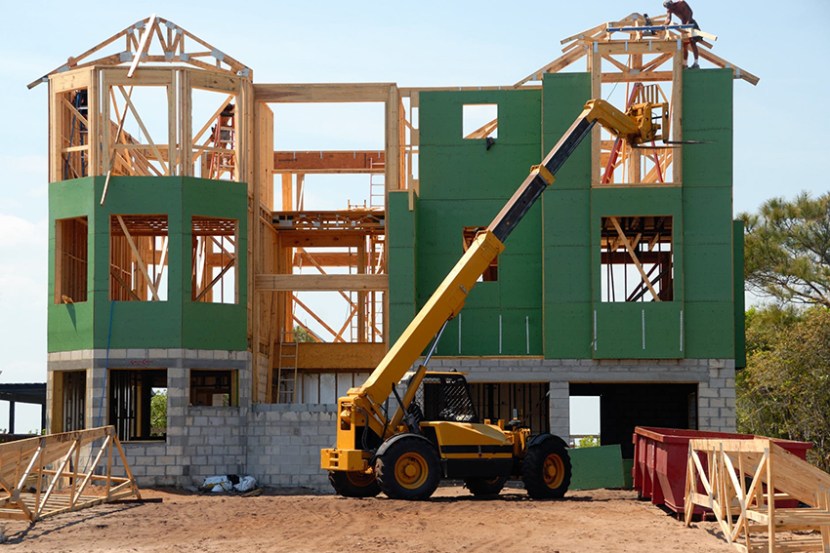
January Housing Starts Down, But Outlook Good

Housing starts started the year on a down note, HUD and the Census Bureau reported yesterday, but the pace remained solid, analysts said.
The report said privately owned housing starts in January came in at a seasonally adjusted annual rate of 1.567 million units, 3.6 percent below the revised December estimate of 1.626 million, but 21.4 percent higher than a year ago (1.291 million). Single‐family housing starts came in at 1.101 million, 5.9 percent below the revised December figure of 1.073 millin. The January rate for units in buildings with five units or more was 547,000.
Regionally, results were mixed. In the South, starts fell by 5.4 percent in January to 778,000 units, seasonally annually adjusted, from 822,000 units in December, but improved by 9.1 percent from a year ago. In the Midwest, starts fell by nearly 26 percent to 180,000 units in January from 243,000 units in December, but improved by nearly 28 percent from a year ago.
In the West, starts rose by 1.2 percent to 431,000 units, seasonally annually adjusted, in January from 426,000 units in December and improved by more than 47 percent from a year ago. In the Northeast, starts rose by nearly 32 percent to 178,000 units in January from 135,000 units in December and improved by nearly 24 percent from a year ago.
“The housing market is still experiencing supply shortages in many areas, but January’s residential construction data show yet another step in the right direction,” said Joel Kan, MBA AVP of Economic and Industry Forecasting. “Following a surge of activity in December, housing starts pulled back slightly in January, but the current pace is still over 1.5 million units–remaining close to the highest levels since 2006.”
Kan noted while single-family starts decreased last month, they exceeded an annual pace of one million units for the second month in a row, and the first time since 2007. Multifamily starts also continue to be robust, rising for the second straight month and seeing the strongest month of production since 1986.
“In a promising development for new housing supply levels, single-family permits increased for the third month and to the highest level since 2007,” Kan said. “Similar to the findings in MBA’s January Builder Applications Survey released this week, homebuilders are continuing to ramp up production to meet the demand from potential buyers, and mild winter weather is helping some of the increased activity in the Midwest. The success of the spring buying season greatly depends on how much new and existing inventory is on the market.”
Mark Vitner, Senior Economist with Wells Fargo Securities, Charlotte, N.C., said despite the drop in housing starts, the 1.57 million-unit pace easily beat consensus expectations and is the second strongest of the expansion. “Home building continues to build momentum, but the coronavirus remains a risk,” he said.
Vitner noted unseasonably mild weather helped keep homebuilding in high gear during January. “It was the sixth warmest December on record, as non-seasonally adjusted starts rose in a month when activity normally falls sharply, producing a huge seasonally adjusted gain,” he said. “January’s decline was actually less than expected and leaves starts running 21% above their total for 2019. If housing construction maintains its current pace, we will see some incredibly strong year-over-year numbers in 2020.”
However, Vitner said, January was also one of the warmest on record, meaning the data once again got an extra boost from seasonal adjustment. “We expect to see some payback this spring,” he said.
The report said privately owned housing units authorized by building permits in January came in at a seasonally adjusted annual rate of 1.551 million, 9.2 percent higher than the revised December rate of 1.420 million and nearly 18 percent higher than a year ago (1.316 million). Single‐family authorizations in January rose to 987,000; 6.4 percent higher than the revised December figure of 928,000. Authorizations of units in buildings with five units or more rose to 522,000 in January, up by 15.2 percent from December and by 16 percent from a year ago.
HUD/Census said privately owned housing completions in January fell to a seasonally adjusted annual rate of 1.280 million, 3.3 percent below the revised December estimate of 1.323 million, but 1.5 percent higher than a year ago (1.261 million). Single‐family housing completions in January fell to 877,000, 3.5 percent below the revised December rate of 909,000. The January rate for units in buildings with five units or more fell to 397,000, down by 2.2 percent from December but up by 18.2 percent from a year ago.
